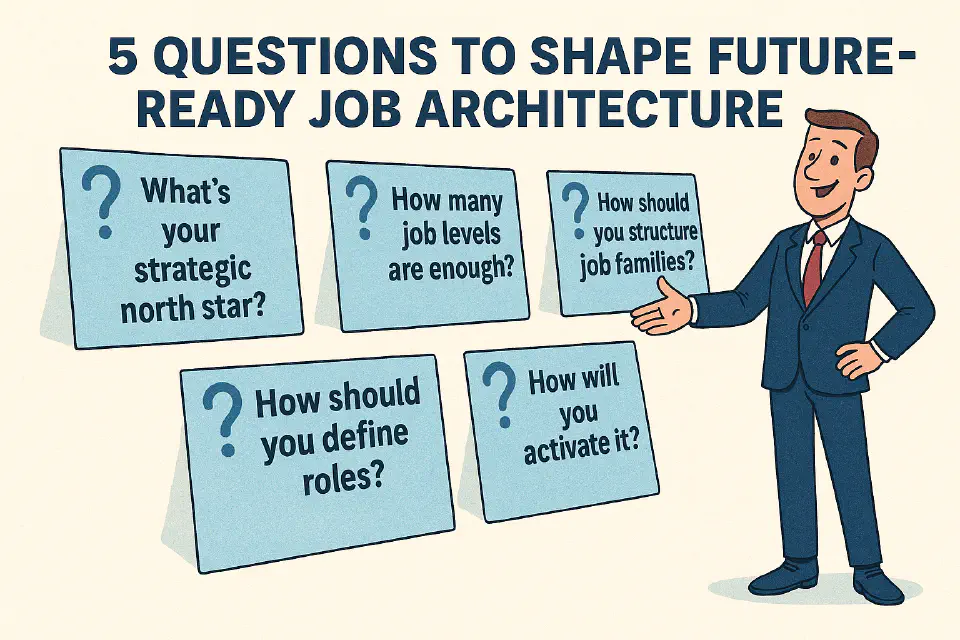
5 Strategic Questions to Shape Future-Ready Job Architecture
A modern job architecture isn’t a static framework—it’s a strategic tool. Here’s how to optimize yours by asking the right questions from the start.
Job architecture isn’t just about boxes on an org chart—it’s the invisible structure that supports every talent decision in your company. When it’s well-designed, it enables growth, agility, and accountability. When it’s outdated or misaligned, it becomes a bottleneck. In today’s fast-changing environment, a future-ready job architecture must be more than organized. It must be strategic.
So how do you move from legacy structures to a system that truly serves your business? It starts with asking the right questions.
1. What’s Your Strategic North Star?
Before you touch any spreadsheet or design framework, pause. What is your organization really trying to achieve?
“Your job architecture should reflect your business strategy—not the other way around.”
An e-commerce company entering five new markets in 12 months will need something very different from a public utility focused on operational efficiency. One might need speed and flexibility; the other, standardization and control.
It helps to anchor your architecture around three primary goals:
- Scalability (e.g. geographic growth, M&A readiness)
- Innovation (e.g. new business models, tech capabilities)
- Efficiency (e.g. cost optimization, process improvement)
Your choice will guide all design decisions—from how many job levels you need to how you define roles.
2. How Many Job Levels Are Enough?
Job levels shape everything from compensation to promotion paths. But getting the number right is a balancing act.
Twelve job levels might seem thorough, but often create artificial distinctions between roles and tiny promotion steps that confuse employees and complicate pay structures. On the flip side, just three levels can make career progression feel distant and arbitrary.
Consider these dimensions:
- Organizational Agility: Fewer levels often mean easier structural shifts.
- Role Complexity: Technical or specialist roles may need more granularity.
- Promotion Philosophy: Do you reward small steps or major leaps?
- Compensation Strategy: Can your pay bands accommodate broad levels?
3. How Should You Structure Job Families?
Job families are the scaffolding that ties your workforce together. They influence internal mobility, pay equity, and talent pipelines. But they’re often either too narrow (fragmented silos) or too broad (vague categories).
Think of job families as career highways, not cul-de-sacs.
You might:
- Group by discipline (e.g. all Data & Analytics roles, regardless of department)
- Group by function (e.g. separate marketing analysts from finance analysts)
Each approach has trade-offs.
When defining job families, ask:
- Can employees easily see career paths across and within families?
- Do new skills (e.g. AI, automation) fit cleanly into your model?
- Can you reassign people quickly during transformation?
- Will your framework still make sense in 3–5 years?
4. How Should You Define Roles?
Clear role definitions are the backbone of performance, compensation, and development. But clarity doesn’t mean rigidity.
Each role should define the what and the why—not just the how.
Start with:
- Core Responsibilities: What outcomes is this role accountable for?
- Key Skills & Competencies: What’s required to succeed?
- Success Metrics: How is performance measured?
- Growth Path: Where can this role evolve?
- Common Language: Use consistent terminology across the org
This isn’t just HR housekeeping. It impacts real decisions:
- Hiring managers can write sharper job descriptions
- Compensation teams can benchmark more accurately
- Employees can self-direct development more effectively
5. How Will You Activate It?
You can build the world’s best framework—and still fail if people don’t understand or adopt it.
That’s why activation is as important as design. You’ll need:
- Clear ownership: Who governs the model, keeps it updated, and resolves edge cases?
- Simple tools: Can employees explore roles and families intuitively?
- Manager training: Do leaders know how to use this model in hiring and development?
- Ongoing feedback: Can you iterate based on how it’s actually used?
Even the best frameworks evolve. As your strategy shifts, your architecture should, too. Build in annual checkpoints to reassess structure, job levels, and definitions.
Final Thoughts
Getting job architecture right isn’t about adding layers or documents. It’s about building a shared language for work. When done well, it becomes the bridge between strategy and people.
The payoff? Faster decisions, smarter resourcing, more meaningful careers.
Start with the five questions above—and build a system that’s as ambitious as your strategy.